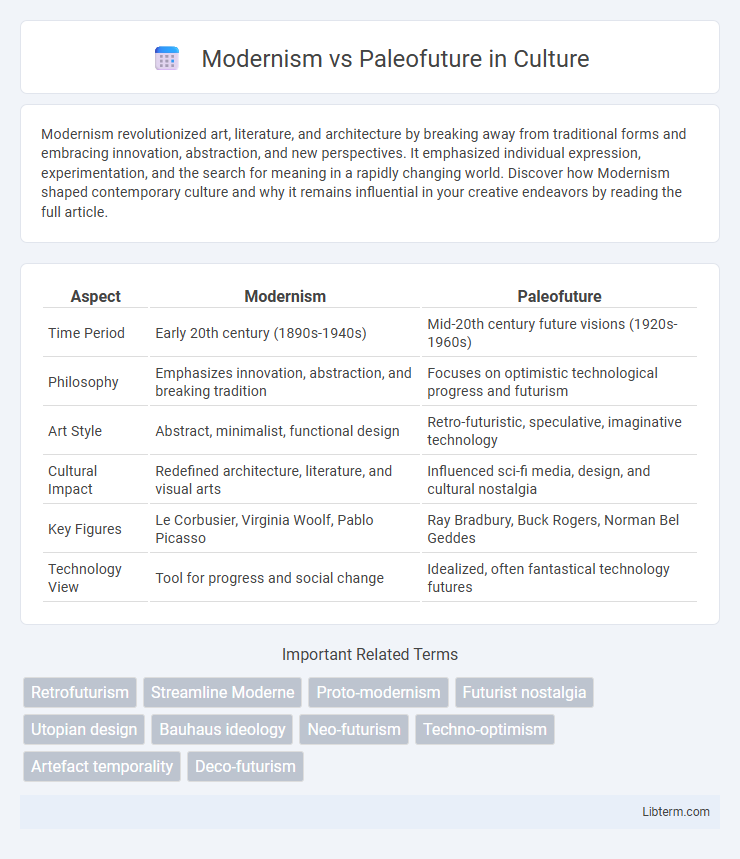Modernism revolutionized art, literature, and architecture by breaking away from traditional forms and embracing innovation, abstraction, and new perspectives. It emphasized individual expression, experimentation, and the search for meaning in a rapidly changing world. Discover how Modernism shaped contemporary culture and why it remains influential in your creative endeavors by reading the full article.
Table of Comparison
| Aspect | Modernism | Paleofuture |
|---|---|---|
| Time Period | Early 20th century (1890s-1940s) | Mid-20th century future visions (1920s-1960s) |
| Philosophy | Emphasizes innovation, abstraction, and breaking tradition | Focuses on optimistic technological progress and futurism |
| Art Style | Abstract, minimalist, functional design | Retro-futuristic, speculative, imaginative technology |
| Cultural Impact | Redefined architecture, literature, and visual arts | Influenced sci-fi media, design, and cultural nostalgia |
| Key Figures | Le Corbusier, Virginia Woolf, Pablo Picasso | Ray Bradbury, Buck Rogers, Norman Bel Geddes |
| Technology View | Tool for progress and social change | Idealized, often fantastical technology futures |
Introduction to Modernism and Paleofuture
Modernism emerged in the late 19th and early 20th centuries as an artistic and cultural movement emphasizing innovation, abstraction, and a break from traditional forms to reflect the complexities of the modern world. Paleofuture explores how past generations envisioned the future, often focusing on early 20th-century predictions and speculative designs that highlight the contrast between historical optimism and contemporary technological realities. The interaction between Modernism's progressive ideals and Paleofuture's nostalgic futurism provides insight into evolving societal attitudes toward progress and imagination.
Defining Modernism: Concepts and Origins
Modernism emerged in the late 19th and early 20th centuries as a radical break from traditional artistic, cultural, and social norms, emphasizing innovation, abstraction, and a quest for new forms of expression. Rooted in rapid industrialization, urbanization, and technological advancements, Modernism challenged established conventions through movements like Cubism, Futurism, and Surrealism, reflecting a deep engagement with contemporary realities and psychological exploration. The movement's origins are closely linked to philosophical ideas from figures such as Friedrich Nietzsche and Sigmund Freud, who influenced its focus on subjectivity, fragmentation, and the unconscious.
Understanding Paleofuture: Meaning and Relevance
Paleofuture refers to the historical visions and predictions of the future from past eras, capturing how people imagined technology, society, and progress. Understanding paleofuture offers valuable insights into the cultural and technological hopes, fears, and expectations of different times, providing a contextual contrast to modernism's emphasis on innovation and present-day futures. This study reveals the evolving relationship between past aspirations and contemporary technological realities, highlighting how future imaginaries shape and reflect societal values.
Key Characteristics: Modernism vs Paleofuture
Modernism emphasizes innovation, abstraction, and a break from traditional forms, characterized by experimentation in art, architecture, and literature, often reflecting a fragmented view of reality and a search for new meanings. Paleofuture, in contrast, represents nostalgic and speculative visions of the future from the past, marked by optimistic technology-driven progress, sleek retro-futuristic designs, and utopian ideals rooted in early 20th-century imagination. The key difference lies in Modernism's focus on present transformation and existential questioning versus Paleofuture's speculative and idealized projections of a technologically advanced future.
Influential Figures and Movements
Modernism, shaped by figures like Le Corbusier and Virginia Woolf, emphasized innovation, abstraction, and a break from traditional forms across architecture, literature, and art, fostering movements such as Cubism, Futurism, and Surrealism. Paleofuture, often associated with retrofuturism enthusiasts and historians, revisits early 20th-century visions of the future, highlighting the optimism and design aesthetics of classic science fiction and mid-century technological predictions. Both movements influence contemporary culture by contrasting Modernism's revolutionary spirit with Paleofuture's nostalgic reimagining of past futures.
Comparative Analysis: Art, Architecture, and Design
Modernism emphasizes minimalism, functionalism, and abstraction in art, architecture, and design, championing sleek lines and innovative materials like steel and glass. Paleofuture, rooted in retro-futurism, envisions technology and design through a nostalgic lens, featuring bold, exaggerated forms, and imaginative, often optimistic depictions of future possibilities. While Modernism seeks practicality and timelessness, Paleofuture prioritizes fantastical aesthetics and speculative concepts reflecting past eras' visions of the future.
Social and Cultural Contexts
Modernism emerged in the early 20th century, reflecting rapid industrialization and urbanization that challenged traditional social norms and cultural values. Paleofuture, rooted in early 20th-century speculative visions, emphasizes nostalgic and optimistic predictions about technology and society that often contrast with Modernism's critical and fragmented perspectives. Socially, Modernism sought to confront alienation and individualism, while Paleofuture envisioned harmonious technological progress shaping cultural identity and collective future-oriented aspirations.
Impact on Technology and Innovation
Modernism emphasized progress, functional design, and the embrace of new materials, fostering breakthroughs in architecture, transportation, and communication technologies. Paleofuture reflects early 20th-century futuristic visions, inspiring innovation through imaginative predictions of flying cars, space travel, and advanced robotics. Both movements propelled technological advancement by shaping cultural expectations and driving creative experimentation in science and engineering.
Modernism and Paleofuture in Popular Culture
Modernism in popular culture emphasizes innovation, abstraction, and breaking with traditional forms, reflecting early 20th-century artistic and architectural movements such as Bauhaus and Cubism. Paleofuture explores retro-futuristic themes, envisioning the future through the lens of past decades, often highlighting optimistic technological predictions from the mid-20th century, like flying cars and space colonies. Both modernism and paleofuture shape narratives in media and design, contrasting contemporary realities with imagined or idealized futures.
Future Perspectives: What’s Next?
Modernism envisions the future through progress, technology, and innovation, emphasizing sleek design and functionalism as pathways to societal advancement. Paleofuture reflects past conceptions of the future, often idealizing retro-futuristic aesthetics and early 20th-century technological optimism, which now inform contemporary nostalgia-driven design. Future perspectives increasingly blend Modernism's forward-looking ideals with Paleofuture's imaginative vision, fostering hybrid approaches in smart cities, sustainable technologies, and speculative urban planning.
Modernism Infographic

 libterm.com
libterm.com